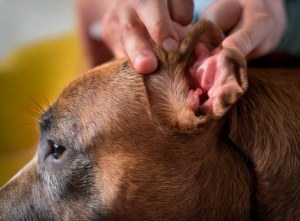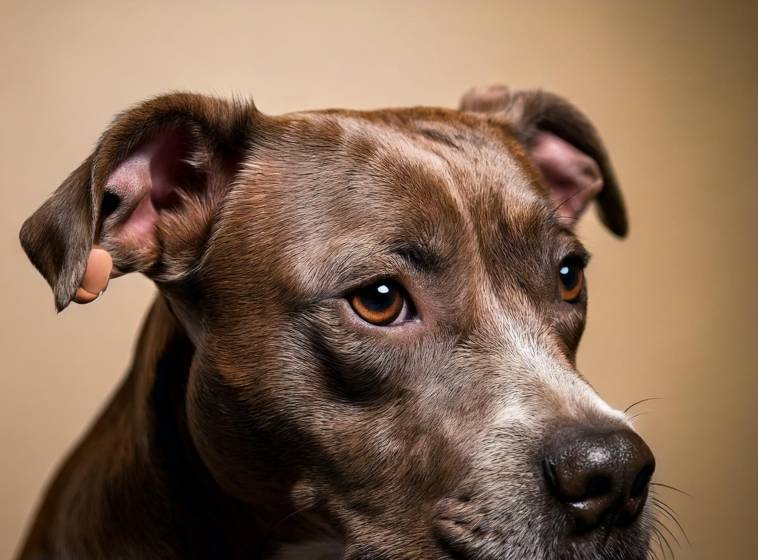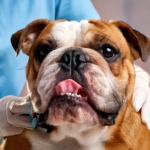Last updated on October 24th, 2024
Here’s an overview:
Introduction to Ear Infections in Pitbulls
Ear Mites, Lice, and other parasites
Foreign Bodies and Other Debris
Bacterial and Fungal Infections
Symptoms of Ear Infections in Pitbulls
How It Is Done Ear Infection Diagnosis in Pitbulls
Preventive Measures and Regular Cleaning
Prevention through Diet and Nutrition
When a Pet Owner’s Intervention is Necessary
Conclusion and Final Suggestions on Ear Infections in Pitbulls
Introduction to Ear Infections in Pitbulls
Pitbulls face one frequent health issue which is an ear infection. It is the inflammation of the ears or more particularly the ear canal. Ear infections usually occur due to the following:
- Allergic reactions
- Moisture content
- Wax deposits
- Presence of foreign objects
- Infection with bacteria or yeast
It is important to catch symptoms early on. Ear Infections in Pitbulls:
- Continuous scratching
- Intense head shaking
- Red stains, swelling of the area
- Bad smells
- Some sort of liquid discharge
If ear canals are scrutinized every now and then due to checkups, complications can be avoided. Being knowledgeable and aircraft about the causes, clinical symptoms and preventive actions goes a long way in safeguarding the ears of the Pitbull’s.
Anatomy of a Pitbull’s Ear
The anatomy of the Pitbull’s ear is important for ear care as first aid; there are three sections of the ear:
- Outer Ear: Pinna also known as the ear flap and the ear canal. The role of the pinna is to gather sound and then guide it into the ear canal.
- Middle Ear: Composed of the tympanic membrane as well as three internal small bones known as the ostioles (malleus, incus, stapes) and the connecting Eustachian tube in this region.
- Inner Ear: Contains the cochlea and vestibular system, responsible for the senses of hearing and balance. The cochlea converts acoustics into nerve impulses.
Allergies and Sensitivities
Allergic reactions and sensitivities predispose Pitbulls to ear infections Pokes. Their identification is important.
Such allergies include:
- Dust mites
- Pollen
- Some foods
- Flea saliva
The following symptoms may recur:
- Itchy skin that tends to be excessive
- Red rash on the skin
- Swollen skin
- Ear drainage
Moisture and Humidity
Moisture and humidity are also critical factors for the development of ear infections in Pit Bulls. Bacterial or yeast infections will invade after excessive moisture has been provided. Owners should:
- Check and clean the ears of their Pitbull dogs to avoid excessive moisture.
- Pat the dog’s ears with absorbent materials after a long swim or a bath.
- To reduce the amount of humidity in the general area, the dog’s housing should be well ventilated.
- If ear moisture problems are frequent, stay away from water-based cleaners for the ears.
- Place a dehumidifier in the residence to improve the air quality.
Ear Mites, Lice, and other parasites
Pitbulls tend to have an uncontrollable itch due to infestations of ear mites, which are small parasitic organisms. Infestation if not treated may also promote secondary infections. Ear mites may be diagnosed by veterinarians through ear swab scrape examination.
Signs of Ear Mites:
- Scratching a lot.
- Reading of the head in a jerky motion.
- Brownish black ear wax.
Treatment:
- Topical treatment: Ear mites are eliminated by medications that are applied topically to the ear canal.
- Ear cleaning: Easy to maintain ear health by cleaning the ears every week with solutions that the physician approves of.
- Systemic treatments: Oral medications that are prescribed for extended severe cases may be prescribed by the vet’s commanders.
Prevention:
- Infections and parasites in the ear can be prevented by performing ear cleanings and examinations regularly.
- The dog’s ears must be kept clean at all times.
- Close all doors and windows around an infected mountain dog to keep the disease from spreading.
A trained veterinarian should be consulted to determine the precise diagnosis and treatment strategies.
Foreign Bodies and Other Debris
It is necessary to keep looking for foreign bodies and debris since they could cause infections of the ears. These causes damage to the erosion creating precarious irritation and inflammation paving way to infections. There are a few debris sources which include;
- Grass seeds
- Little bugs
- Dirt, sand
In order to control this, the following methods should be used:
- Routine Professional Examination: Bacteria-free ears should be present on the Pitbulls and so the owners should take great care to change the water once a week.
- Washing: Cleanse ears using ear-cleaning solutions that are medically advised for dogs.
- Drying: Dry the ears after swimming or bathing.
- Professional Help: Consider taking the pet to a veterinarian if a foreign object has been pushed too deep or is causing pain.
If these aspects are attended to in a proper manner, the chances of infection will be minimal.
Bacterial and Fungal Infections
Pitbulls do not have it easy as it relates to their ears as they may suffer from bacterial and fungal infections which are quite common in these animals. The ears also exhibit signs of infection which are unpleasant including redness, swelling, drainage, and odors. If there is treatment, it should be administered early to avoid further complications.
Causing factors of Ear Infections in Pitbulls:
- Moisture: If there is extra moisture, it encourages the bacteria to flourish.
- Allergies: Food or outside allergies may also increase the chances.
- Foreign Objects: Flotsam and jetsam which have become stuck in the ear canal.
Treatment
- Topical Medications: This can be antifungal or antibiotic drops which a veterinary doctor can prescribe.
- Cleaning: Cleaning the ear of the pet with special ear cleaning solutions from the vet.
- Oral Medications: In extreme cases of the ear inflammation, people use oral systemic antibiotics or antifungals.
Prevention
- Routine Checks: Check the ears of the Pitbull on a regular basis so signs of dawning infection increments can be detected.
- Drying Ears: Make sure the ears are dry by drying after places like swimming pools or after baths.
- Diet Management: Consider feeding a hypoallergenic diet if you suspect food allergies.

Symptoms of Ear Infections in Pitbulls
- Frequent scratching: When an ear suffers from infection, the pit bull might be scratching it too much.
- Redness and Swelling: Due to blockage in the ear canal, irritation can occur which can lead to that area being red and vats.
- Odor: If there is pus from the ear and that pus hasn’t drained, it will produce a really bad smell.
- Discharge: Dark or yellowish discharge from the ear.
- Head Shaking: Head is shaken often in the context of stress.
- Pain: When the ear is pushed or twisted the animal shows pain.
- Hearing Loss: Probable partial hearing loss only due to blockage.
- Behavioral Changes: Some changes in the normal behavior, for instance, irritability or lethargy.
How It Is Done Ear Infection Diagnosis in Pitbulls
Ear infections in Pitbulls are diagnosed by observing their clinical signs and lesions in a proper manner and then providing appropriate treatment.
- Visual Examination: A veterinarian checks the ear canals for inflammation and for the exudate.
- Odor Assessment: The presence of an unusual smell from an ear could be infection.
- Microscopic Analysis: The examination of the swab from the ear under the microscope to see bacteria or yeast.
- Culture Tests: Cultures may be sent to determine the type of the infecting organism and the antibiotic that would be most effective.
- History and Symptoms: The history of illness in a dog with clinic signs of shaking the head or scratching.
Preventive Measures and Regular Cleaning
Preventive measures remain vital in reducing the episodes of ear infections in Pitbulls. Routinely examine the ears in order to locate the presence of foreign material and detect starting infections. Clean ears once a week with a commercial ear-cleaning solution after consultation with a veterinarian.
- Inspect Ears: Visually assess them for signs of any swelling, redness, or any secretion.
- Cleaning the Ears: Use a pH-adjusted cleaning agent. Don’t use cotton sticks.
- Drying the Ears: They need to be dry afterwards so that they do not hold moisture.
- Diet: Provide a healthy diet to increase the immunity levels.
- Grooming: Maintain the canals of the ears without too much hairs.
Visiting the vet regularly helps to determine early symptoms and prevent the condition from escalating.
Prevention through Diet and Nutrition
A well-balanced diet can aid the immune system of Pitbulls, thus helping prevent ear infections.
- Proteins from good sources: Helps in improving immune defense.
- Omega Fatty Acids: Anti-inflammatory compounds that enhance ear health and contain fish oils.
- Probiotics: Help in healthy gut flora which then helps with immunity.
- Vitamins and minerals are essential: For ear and skin health, include Vitamin A, Vitamin E and zinc.
Owners must avoid many of the foods that are pack with fillers, additives, and allergens as those can lead to aggravation of the infections.
When a Pet Owner’s Intervention is Necessary
There are specified conditions that require a vet consultation urgently. These include:
- Symptoms that do not improve or continue to develop even when treated with home remedy
- Ear swelling or redness that is quite severe
- More than the usual amount of ear wax or balance problems
- Hearing changes such as presence of blood or pus
- Unprovoked aggression or hyperactivity
- Ear discharge that is of a very unpleasant odor
- Diagnosis of ear infections more than once based on history
Seeking a professional ear infection in Pitbulls helps ensure that there is correct treatment and diagnosis. A few case scenarios include those that will require prescription medication, advanced diagnostics or surgical intervention. However, veterinary intervention at an early stage avoids complications and optimizes the management of Pitbull ear infections.
Conclusion and Final Suggestions on Ear Infections in Pitbulls
When it comes to ear infections in Pitbulls the principles are prevention and control. To enhance the effectiveness of the treatment of ear infections in Pitbulls, consider the following recommendations:
- Pitbull Seeks Vulnerable Spots: Such potent preventive agents can be regular weekly ear checks for redness or tender spots and cleaning done in moderate conditions.
- Ear Inspection: Owner should examine the ears of the Pitbull before putting it to a more forceful wash.
- Limit Mites: A braider should kill all bacteria on the navy head part of the ear near the ear drum.
- Avoid Heating: After bathing, use bath caps and these will stay on for up to twenty two hours or even longer and no heating will occur.
- Regular Vet Check Up Visits: Veterinary consultations help to diagnose problems at an early stage and manage such problems professionally.
Article by: Tawab Sukhera (Ethologist)




